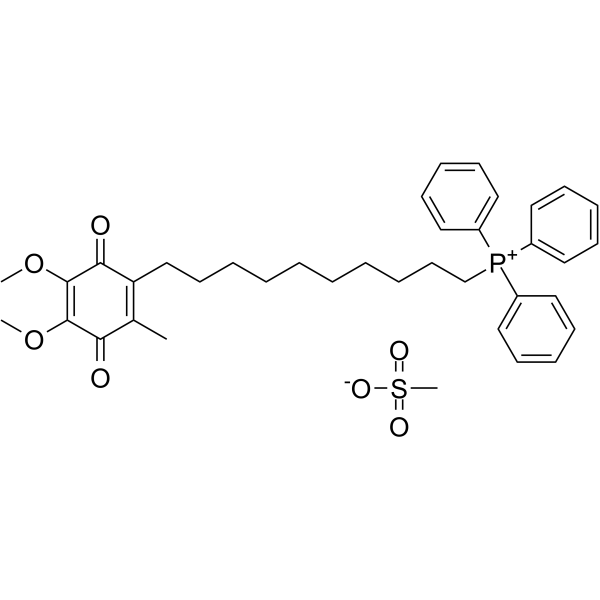上海金畔生物科技有限公司为生命科学和医药研发人员提供生物活性分子抑制剂、激动剂、特异性抑制剂、化合物库、重组蛋白,专注于信号通路和疾病研究领域。
Mitoquinone mesylate (Synonyms: 米托蒽醌甲磺酸盐; MitoQ mesylate; MitoQ10 mesylate) 纯度: ≥98.0%
Mitoquinone mesylate是一种基于TPP的线粒体靶向抗氧化剂,可防止氧化损伤。

Mitoquinone mesylate Chemical Structure
CAS No. : 845959-50-4
| 规格 | 价格 | 是否有货 | 数量 |
|---|---|---|---|
| Free Sample (0.1-0.5 mg) | Apply now | ||
| 10 mM * 1 mL in DMSO | ¥1643 | In-stock | |
| 5 mg | ¥1100 | In-stock | |
| 10 mg | ¥1850 | In-stock | |
| 25 mg | ¥3900 | In-stock | |
| 50 mg | ¥6900 | In-stock | |
| 100 mg | 询价 | ||
| 200 mg | 询价 |
* Please select Quantity before adding items.
Mitoquinone mesylate 相关产品
•相关化合物库:
- Drug Repurposing Compound Library Plus
- Clinical Compound Library Plus
- Bioactive Compound Library Plus
- Immunology/Inflammation Compound Library
- Metabolism/Protease Compound Library
- NF-κB Signaling Compound Library
- Stem Cell Signaling Compound Library
- Anti-Cancer Compound Library
- Clinical Compound Library
- Anti-Aging Compound Library
- Drug Repurposing Compound Library
- Antioxidants Compound Library
- Oxygen Sensing Compound Library
- Ferroptosis Compound Library
- Pyroptosis Compound Library
- Mitochondria-Targeted Compound Library
- Targeted Diversity Library
- Rare Diseases Drug Library
| 生物活性 |
Mitoquinone mesylate is a TPP-based, mitochondrially targeted antioxidant in order to protect against oxidative damage[1]. |
||||||||||||||||
|---|---|---|---|---|---|---|---|---|---|---|---|---|---|---|---|---|---|
| 体外研究 (In Vitro) |
Mitoquinone (MitoQ) is a mitochondria-targeted antioxidant.The optimal doses for Mitoquinone (MitoQ) and DecylTPP treatment are selected from dose-response experiments during 4-h cold storage (CS). The potential protective benefits of Mitoquinone treatment against CS injury are tested initially using MitoSOX Red, a mitochondrial-targeted fluorescent dye that measures mitochondrial superoxide generation. Normal rat kidney (NRK) cells exposed to CS result in a ~2-fold increase in fluorescence due to mitochondrial superoxide compared with untreated cells. Mitoquinone offers significant protection against CS-induced mitochondrial superoxide generation; whereas the control compound DecylTPP does not offer any protection. Mitoquinone treatment markedly decreases mitochondrial superoxide generation, whereas kidneys treated with DecylTPP have comparable levels of mitochondrial superoxide to kidneys exposed to CS alone[1]. 上海金畔生物科技有限公司 has not independently confirmed the accuracy of these methods. They are for reference only. |
||||||||||||||||
| 体内研究 (In Vivo) |
Mitoquinone (MitoQ) treatment significantly reduces pancreatic oedema and neutrophil infiltration. MitoQ dose-dependently increases serum amylase with an approximate doubling at the higher dose. MitoQ treatment nearly doubles lung MPO activity induced by Caerulein with a significant increase of serum IL-6 levels also evident at 10 mg/kg (dose 1)[2]. 上海金畔生物科技有限公司 has not independently confirmed the accuracy of these methods. They are for reference only. |
||||||||||||||||
| Clinical Trial |
|
||||||||||||||||
| 分子量 |
678.81 |
||||||||||||||||
| Formula |
C38H47O7PS |
||||||||||||||||
| CAS 号 |
845959-50-4 |
||||||||||||||||
| 中文名称 |
米托蒽醌甲磺酸盐;米拖蒽醌甲磺酸盐 |
||||||||||||||||
| 运输条件 |
Room temperature in continental US; may vary elsewhere. |
||||||||||||||||
| 储存方式 |
4°C, sealed storage, away from moisture *In solvent : -80°C, 6 months; -20°C, 1 month (sealed storage, away from moisture) |
||||||||||||||||
| 溶解性数据 |
In Vitro:
DMSO : 50 mg/mL (73.66 mM; Need ultrasonic) H2O : 8.33 mg/mL (12.27 mM; ultrasonic and warming and heat to 60°C) 配制储备液
*
请根据产品在不同溶剂中的溶解度选择合适的溶剂配制储备液;一旦配成溶液,请分装保存,避免反复冻融造成的产品失效。 In Vivo:
请根据您的实验动物和给药方式选择适当的溶解方案。以下溶解方案都请先按照 In Vitro 方式配制澄清的储备液,再依次添加助溶剂: ——为保证实验结果的可靠性,澄清的储备液可以根据储存条件,适当保存;体内实验的工作液,建议您现用现配,当天使用; 以下溶剂前显示的百
|
||||||||||||||||
| 参考文献 |
|
| Cell Assay [1] |
Normal rat kidney proximal tubular cells (NRK-52E) are maintained in six-well 100 or 150-mm, or 150-mm plates in a humidified incubator gassed with 5% CO2 and 95% air at 37°C in DMEM containing 5% fetal calf serum (FCS). Cells are grown to 60% confluence and divided into four treatment groups: 1) untreated (Untx), 2) CS, 3) CS+Mitoquinone (MitoQ), and 4) CS+DecylTPP. Untreated cells remained at 37°C in DMEM containing 5% FCS (group 1). CS is initiated by washing cells with cold PBS twice and storing them in UW/Viaspan solution alone (4 h at 4°C) (group 2), CS+Mitoquinone (1 μM) (group 3), or CS+DecylTPP (1 μM) (group 4). In separate experiments, cells are exposed to CS plus RW by replacing UW solution alone or UW solution containing Mitoquinone or DecylTPP with DMEM containing 5% FCS overnight (18 h at 37°C)[1]. 上海金畔生物科技有限公司 has not independently confirmed the accuracy of these methods. They are for reference only. |
|---|---|
| Animal Administration [2] |
Mice[2] 上海金畔生物科技有限公司 has not independently confirmed the accuracy of these methods. They are for reference only. |
| 参考文献 |
|
所有产品仅用作科学研究或药证申报,我们不为任何个人用途提供产品和服务
